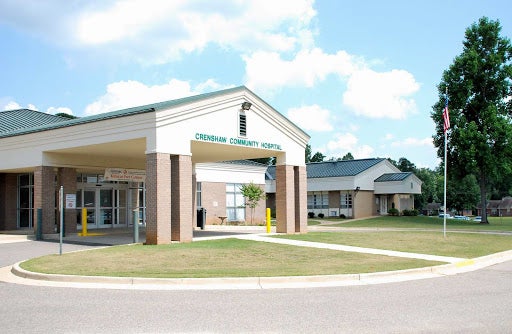Hospital issues stem from massive capital debt
Published 2:16 pm Friday, October 30, 2020
|
Getting your Trinity Audio player ready...
|
With just days to go before Crenshaw County voters go to the polls to decide whether or not they wish to pay additional property taxes to help the ailing Crenshaw Community Hospital, The Luverne Journal sought additional information under the Freedom of Information Act about events that lead to the financial woes facing the hospital.
Crenshaw County Health Care Authority Attorney Levi Nichols said to fully understand the authority’s debt, residents must go back to a massive renovation project on the hospital from 2005-2007.
Nichols said everything was renovated except the South Wing.
During that time, the hospital incurred debt and did a bond issue. The bond issue was refinanced in 2017.
During 2017, most government agencies were refinancing old bonds due to competitive interest rates that allowed them to decrease the overall amount of debt owed.
Nichols said $5.6 million is left on that.
Additionally, in 2017, the state of Alabama did a survey on the South Wing, which is the hospital behavioral health unit, and the only portion of the hospital not renovated during the massive renovation project.
Nichols said the state told officials if the South Wing was not renovated, it would have to close and they would not be able to renew contracts with state mental health.
Nichols said while the ER loses money, the South Wing is a profitable department within CCH.
“When you look at the big picture, some lose money, some make money,” he said.
With that being said, the health care authority members were forced to hire an architect and have plans drawn up for the renovations.
Nichols said it took two years for the state to approve the plans.
That renovation costs $1.3 million and has just begun.
Nichols said while the state mandates the renovations, no money for capital improvements comes from the state for this project.
“Where does the money come from? We had to borrow enough to pay off the $1.5 million line of credit and then needed $1.3 million for renovations.”
Nichols said the health care authority also borrowed extra in case of continued COVID-19 issues.
The total borrowed is $4.8 million from USDA for which the health care authority pledged $1 million to USDA as collateral.
The hospital also received $1.2 million in PPP funds to cover payroll. PPP funds will be forgiven if used properly.
“The only income the health care authority gets is from ad valorem taxes, tag and title taxes through probate and we were getting rent from leasing the hospital,” he said of how the health care authority typically operates.
Nichols explained that the authority had never been responsible for revenue and debts until November 2019.
“That’s when we took back over the hospital from PRM,” he said.
Another woe that the health care authority faced when they took control back of the hospital was that PRM had the provider numbers for the hospital and prior to PRM leasing the hospital Baptist had the provider numbers.
“It took from November until basically last month to get all the numbers in the health care authority’s name,” Nichols said. “We needed those numbers to get paid.”
Nichols said the health care authority sued PRM last year and forced the company into bankruptcy.
He said that some advised they should close the hospital until they got the provider number situated, but the board felt it was best to keep the hospital open at all costs.
“We sued them in state court,” he said. “We had to have a way to bill from November until we got the provider numbers.”
Couple the fact that the hospital needed provider numbers to bill with the COVID-19 pandemic and it’s a recipe for near disaster.
To combat that, the health care authority got a line of credit from First Citizen’s Bank for $1.5 million.
The Crenshaw County Commission secured $1 million and the city of Luverne secured $500,000.
According to board meeting minutes obtained by The Journal, at the January 17, 2020 board meeting, Nichols told the board that the revenue cycle from Nov. 10 to January 17 was just a little more than $600,000.
Board minutes show that he told the board that the total drawn on the line of credit was around $1.2 million of the $1.5 million that was granted.
Minutes also show that Nichols told the board that if revenues did not go up, the board would have to look at other sources of funding, which would need to be addressed by the end of January 2020.
CPA Daryl Betts told the board that the board’s funds had been exhausted and they were holding other invoices to be paid due to the issue.
By February, the health care authority was experiencing cash flow issues.
Nichols explained, according to February 2020 board minutes, that the line of credit at First Citizens Bank, was maxed out.
Nichols said the hospital loses about $200,000 to $300,000 per month.
“If the hospital could break even, it would be a great thing,” he said.
The health care authority now has help from Alliant, which is a management company that helps the board oversee the hospital.
“It helps the authority make good decisions,” he said. “They help with purchasing. They get better deals on equipment and services.”
Board minutes show that the health care authority is paying Alliant $20,000 per month and that after the first year, that amount will be re-evaluated.
Additionally, Nichols said that the hospital uses an employee leasing company – Modern Business Associates — to get employees.
“It wasn’t a good call for the authority to employ that many people,” he said.
Nichols said if the ad valorem tax is passed, it will be used to service debt.
“What people don’t understand is that the debt is for capital improvements,” he said.
The ad valorem tax is expected to generate around $400,000 per year.
The increase would cost a taxpayer who has property assessed at $50,000 an additional $15 per year.






